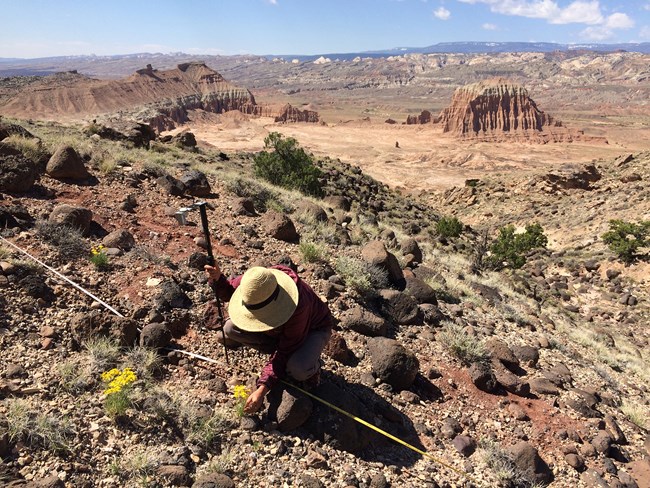Last updated: January 17, 2025
Article
Rangeland restoration and the RAD framework at Capitol Reef National Park

NPS
At Capitol Reef National Park in southern Utah, staff are applying the RAD framework in cattle grazing allotments in the Upper South Desert area and an active allotment in the southern portion of the park. Two allotments were designated in the Upper South Desert when the park was established in 1971, and the impacts of livestock grazing and climate change on the grass-shrubland ecosystems have manifested in decreased soil condition, species loss, and increased abundance of invasive plants. Capitol Reef National Park stewardship here focuses on ecosystem restoration in response to land use impacts, as well as a forward-looking approach to ongoing and anticipated climate change impacts.
Most of the retired grazing allotment area in the Upper South Desert is healthy; native species are dense and diverse, nonnative vegetation is largely absent, and the earth is blanketed by biological soil crust, which provides essential nutrients and water for vascular plants as well as resistance against erosion. Park managers can comfortably accept autonomous dynamics in these areas while continuing to monitor ecosystem conditions and processes.
Understanding the RAD Framework
The RAD framework consists of three strategies:
- Resist: Working to maintain existing conditions or slow the rate of change based upon historical or acceptable current ecosystem conditions. This often involves direct interventions to counteract environmental changes.
- Accept: Allowing the system to change without intervention.
- Direct: Actively steering changes toward desired outcomes, which may involve redesigning or repurposing systems to function under new conditions.
Capitol Reef National Park managers are also choosing to accept ecological change in areas of the park that are in the very worst condition—specifically, parts of the Upper South Desert entirely overwhelmed by invasive species and barren ground where no cost-effective way to restore the land exists. Park managers have made an informed decision to accept these changes until there is a better chance of recovery. In the future, CARE may begin clearing an active allotment in the southern portion of the park with herbicides to control invasive cheatgrass, moving from accepting to resisting change in that location.
In places where federally listed imperiled species like Last Chance Townsendia-daisy and Wright's fishhook cactus persist, the park focuses on resisting change (i.e., extirpation). These rare species are endemic to South-central Utah and may disappear from the wild as heat stress and drought conditions worsen with climate change. The cacti are also small and move slowly across the landscape, and unfavorable climatic conditions reduce seed sets such that they are too low for restoration. Without the science, resources, or knowledge to better support their growth, Capitol Reef National Park must resist the extinction of endemic cacti by keeping weeds at bay and hoping longer-term solutions arrive for these species.
Parts of the Upper South Desert are currently transforming, based on past impacts, into an environment characterized by native plant species flourishing alongside nonnatives, with large swaths of erodible bare soil in between. Park stewards see restoration potential in the patches of vegetation and young soil crust development. However, instead of focusing time and resources on eliminating nonnative species, the focus is simply on expanding vegetative cover to minimize erosion. Here, Capitol Reef National Park has chosen to direct change with the help of the USGS RestoreNet network application. Of the several experimental designs that RestoreNet recommends, park stewards found that digging small pits in the landscape created opportunities for vegetation to flourish by retaining moisture and soil and allowing seeds—both native and nonnative—to settle and germinate. By directing the growth of all vegetation in this part of the Upper South Desert, park stewards are cultivating better conditions than what would have otherwise existed if they simply accepted an autonomous transition.
Along with new cheatgrass management techniques, taking advantage of local disturbances to restore native vegetation, and enlisting the help of Invasive Plant Management Teams and youth crews, Capitol Reef National Park is using every part of the RAD framework to steer the park through climate change in a rapidly changing landscape.
